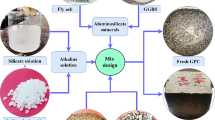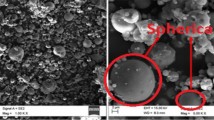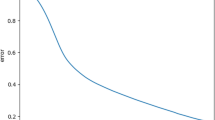Abstract
The purpose of this research study is twofold: (1) to investigate the factors that influence the mechanical properties of Geopolymer Concrete (GPC) made from fly ash (FA) and phosphogypsum (PG), and (2) to develop a method for predicting the mechanical properties based on experimental data. To achieve this, the researchers prepared GPC samples with varying levels of PG powder as a replacement for FA at different sodium hydroxide (NaOH) molarities, and tested their mechanical properties. The optimum mix design was obtained at 30% partial replacement of FA with PG at 12 M NaOH, and maximum compressive strength achieved was 47.97 MPa. Three distinct artificial neural network (ANN) techniques were then employed to predict the mechanical properties (Compressive Strength, Flexural Strength, and Split Tensile Strength) of the GPC using the experimental data. The accuracy of the predictions was assessed using performance statistics based on coefficient of determination (R2), root mean square error (RMSE), and Taylor diagram. The ANN models show good prediction efficiency with R2 value above 0.85.










Similar content being viewed by others
Data availability
All the data used for the development of model has already been included in the manuscript. Other data related to this study may be made available on reasonable request from the corresponding author.
References
Alam, S., S. K. Das, & B. H. Rao. (2019). Strength and durability characteristic of alkali activated GGBS stabilized red mud as geo-material. Constrution and Building Materials, 211, 932–942. Elsevier Ltd. https://doi.org/10.1016/j.conbuildmat.2019.03.261.
Albidah, A. S. (2021). Effect of partial replacement of geopolymer binder materials on the fresh and mechanical properties: A review. Ceramics. International, (December 2020). Elsevier Ltd. https://doi.org/10.1016/j.ceramint.2021.02.127.
Amran, M., S. Debbarma, & T. Ozbakkaloglu. (2021). Fly ash-based eco-friendly geopolymer concrete: A critical review of the long-term durability properties. Constrution and Building Materials, 270: 121857. Elsevier Ltd. https://doi.org/10.1016/j.conbuildmat.2020.121857.
Amrani, M., Y. Taha, A. Kchikach, M. Benzaazoua, & R. Hakkou. (2020). Phosphogypsum recycling: New horizons for a more sustainable road material application. Journal of Building Engineering 30 (January): 101267. Elsevier Ltd. https://doi.org/10.1016/j.jobe.2020.101267.
Bebana, M. V., K. Ziat, N. Semlal, & M. Saidi. (2019). “Modeling compressive strength of Moroccan fly ash–phosphogypsum geopolymer bricks.” SN Applied Sciences, 1 (12). Springer International Publishing. https://doi.org/10.1007/s42452-019-1736-1.
Chen, K., D. Wu, L. Xia, Q. Cai, & Z. Zhang. (2021). “Geopolymer concrete durability subjected to aggressive environments – A review of influence factors and comparison with ordinary Portland cement. Constrution and Building Materials, 279: 122496. Elsevier Ltd. https://doi.org/10.1016/j.conbuildmat.2021.122496.
Chen, M., P. Liu, D. Kong, Y. Wang, J. Wang, Y. Huang, K. Yu, & N. Wu. (2022). Influencing factors of mechanical and thermal conductivity of foamed phosphogypsum-based composite cementitious materials. Constrution and Building Materials, 346 https://doi.org/10.1016/j.conbuildmat.2022.128462.
Dvorkin, L., N. Lushnikova, & M. Sonebi. (2018). Application areas of phosphogypsum in production of mineral binders and composites based on them: a review of research results. MATEC Web Conference, 149. https://doi.org/10.1051/matecconf/201714901012.
Getahun, M. A., S. M. Shitote, & Z. C. Abiero Gariy. (2018). “Artificial neural network based modelling approach for strength prediction of concrete incorporating agricultural and construction wastes. Constrution and Building Materials, 190, 517–525. Elsevier Ltd. https://doi.org/10.1016/j.conbuildmat.2018.09.097.
Hu, W., Q. Nie, B. Huang, X. Shu, & Q. He. (2018). Mechanical and microstructural characterization of geopolymers derived from red mud and fly ashes.” Journal of Cleaner Production, 186, 799–806. Elsevier Ltd. https://doi.org/10.1016/j.jclepro.2018.03.086.
IS:383. (1970). Specification for coarse and fine aggregates from natural sources for concrete. Indian Standard, 1–24.
IS:10086. (2004). Indian Standard Reaffirmed 2004 Reaffirmed 2008 specification for moulds for use in tests of cement and concrete.
John, S. K., Y. Nadir, & K. Girija. (2021). Effect of source materials, additives on the mechanical properties and durability of fly ash and fly ash-slag geopolymer mortar: A review. Constrution and Building Materials, 280: 122443. Elsevier Ltd. https://doi.org/10.1016/j.conbuildmat.2021.122443.
Kaur, M., J. Singh, & M. Kaur. (2018). Synthesis of fly ash based geopolymer mortar considering different concentrations and combinations of alkaline activator solution. Ceramics International, 44 (2), 1534–1537. Elsevier Ltd and Techna Group S.r.l. https://doi.org/10.1016/j.ceramint.2017.10.071.
Kaveh, A., & N. Khavaninzadeh. (2023). Efficient training of two ANNs using four meta-heuristic algorithms for predicting the FRP strength. Structures, 52 (February): 256–272. Elsevier Ltd. https://doi.org/10.1016/j.istruc.2023.03.178.
Kaveh, A., Bakhshpoori, T., & Hamze-Ziabari, S. M. (2018). GMDH-based prediction of shear strength of FRP-RC beams with and without stirrups. Computers and Concrete an International Journal, 22(2), 197–207.
Kaveh, A., Gholipour, Y., & Rahami, H. (2008). Optimal design of transmission towers using genetic algorithm and neural networks. International Journal of Space Structures, 23(1), 1–19. https://doi.org/10.1260/026635108785342073
Kaveh, A., & Iranmanesh, A. (1998). Comparative study of backpropagation and improved counterpropagation neural nets in structural analysis and optimization. International Journal of Space Structures, 13(4), 177–185. https://doi.org/10.1177/026635119801300401
Kaveh, A., & Khalegi, A. (1998). Prediction of strength for concrete specimens using artificial neural network. Asian Journal of Civil Engineering, 2(2), 1–13.
Khale, D., & Chaudhary, R. (2007). Mechanism of geopolymerization and factors influencing its development: a review. Journal of Materials Science, 42(3), 729–746. https://doi.org/10.1007/s10853-006-0401-4
Koshy, N., K. Dondrob, L. Hu, Q. Wen, & J. N. Meegoda. (2019). Synthesis and characterization of geopolymers derived from coal gangue, fly ash and red mud. Construction and Building Materials, 206: 287–296. Elsevier Ltd. https://doi.org/10.1016/j.conbuildmat.2019.02.076.
Kursuncu, B., O. Gencel, O. Yavuz, & J. Shi. (2022). “Optimization of foam concrete characteristics using response surface methodology and artificial neural networks. Construction and Building Materials, 337 (April): 127575. Elsevier Ltd. https://doi.org/10.1016/j.conbuildmat.2022.127575.
Liu, S., P. Fang, J. Ren, & S. Li. (2020). Application of lime neutralised phosphogypsum in supersulfated cement. Journal of Cleaner Production, 272: 122660. Elsevier Ltd. https://doi.org/10.1016/j.jclepro.2020.122660.
Mashifana, T. P. (2019). Chemical treatment of phosphogypsum and its potential application for building and construction. Procedia Manufacturing, 35: 641–648. Elsevier B.V. https://doi.org/10.1016/j.promfg.2019.06.007.
Meesala, C. R., Verma, N. K., & Kumar, S. (2020). Critical review on fly-ash based geopolymer concrete. Structural Concrete, 21(3), 1013–1028. https://doi.org/10.1002/suco.201900326
Mishra, M. C., N. G. Reddy, & B. H. Rao. (2020). “Potential of Citric Acid for Treatment of Extremely Alkaline Bauxite Residue: Effect on Geotechnical and Geoenvironmental Properties. Journal of Hazardous, Toxic, and Radioactive Waste, 24(4): 04020047. https://doi.org/10.1061/(asce)hz.2153-5515.0000541.
Muraleedharan, M., & Y. Nadir. (2021). Factors affecting the mechanical properties and microstructure of geopolymers from red mud and granite waste powder: a review. Ceramics International, 47 (10PA): 13257–13279. Elsevier Ltd. https://doi.org/10.1016/j.ceramint.2021.02.009.
Naenudon, S., A. Wongsa, J. Ekprasert, V. Sata, & P. Chindaprasirt. (2023). Enhancing the properties of fly ash-based geopolymer concrete using recycled aggregate from waste ceramic electrical insulator. Journal of Building Engineering, 68 (February): 106132. Elsevier Ltd. https://doi.org/10.1016/j.jobe.2023.106132.
Nie, Q., W. Hu, B. Huang, X. Shu, & Q. He. (2019). Synergistic utilization of red mud for flue-gas desulfurization and fly ash-based geopolymer preparation. Journal of Hazardous Materials, 369 (January): 503–511. Elsevier. https://doi.org/10.1016/j.jhazmat.2019.02.059.
Pratap, B., S. Mondal, & B. Hanumantha Rao. (2023). Synthesis of alkali activated mortar using phosphogypsum neutralized bauxite residue. Environmental Geotechnics, 1–11. https://doi.org/10.1680/jenge.22.00104.
Qin, X., Y. Cao, H. Guan, Q. Hu, Z. Liu, J. Xu, B. Hu, Z. Zhang, & R. Luo. (2023). Resource utilization and development of phosphogypsum-based materials in civil engineering. Journal of Cleaner Production, 387 (September 2022). https://doi.org/10.1016/j.jclepro.2023.135858.
Reddy, M. S., P. Dinakar, & B. H. Rao. (2018). Mix design development of fly ash and ground granulated blast furnace slag based geopolymer concrete. Journal of. Building Engineering, 20 (September): 712–722. Elsevier Ltd. https://doi.org/10.1016/j.jobe.2018.09.010.
Reddy, N. G., R. S. Nongmaithem, D. Basu, & B. H. Rao. (2020). Application of biopolymers for improving the strength characteristics of red mud waste. Environmental Geotechnics, 1–20. https://doi.org/10.1680/jenge.19.00018.
Ren, Z., L. Wang, H. Wang, S. Liu, & M. Liu. (2023). Solidification/stabilization of lead-contaminated soils by phosphogypsum slag-based cementitious materials. Sciience of the Total Environment, 857 (September 2022): 159552. Elsevier B.V. https://doi.org/10.1016/j.scitotenv.2022.159552.
Shubham, K., S. Metya, & G. Bhattacharya. (2022). Reliability Analysis of Settlement of a Foundation Resting Over a Circular Void. Dynamics of Soil and Modelling of Geotechnical Problems.Lectures Notes Civil Engineering, N. Satyanarayana Reddy, C.N.V., Krishna, A.M., Satyam, ed., 133–143. Springer, Singapore.
Silva, M. V., L. R. de Rezende, M. M. dos A. Mascarenha, & R. B. de Oliveira. (2018). Phosphogypsum, tropical soil and cement mixtures for asphalt pavements under wet and dry environmental conditions. Resources Conservation Recycling, 144, 123–136. Elsevier. https://doi.org/10.1016/j.resconrec.2019.01.029
Vadel, M., B. Khadija, Z. Nawal, & S. Mohamed. (2019). Modeling compressive strength of Moroccan fly ash – phosphogypsum geopolymer bricks. SN Applied Sciiences, 1 (12): 1–9. Springer International Publishing. https://doi.org/10.1007/s42452-019-1736-1.
Vafaei, M., A. Allahverdi, P. Dong, N. Bassim, & M. Mahinroosta. (2021). Resistance of red clay brick waste/phosphorus slag-based geopolymer mortar to acid solutions of mild concentration. Journal of Building Engineering, 34 (November 2019): 102066. Elsevier Ltd. https://doi.org/10.1016/j.jobe.2020.102066.
Verma, M., & Dev, N. (2021). Sodium hydroxide effect on the mechanical properties of flyash-slag based geopolymer concrete. Structural Concrete, 22(S1), E368–E379. https://doi.org/10.1002/suco.202000068
Wan, X., J. Ding, N. Jiao, C. Mou, & M. Gao. (2022). Mechanical and microstructural properties of cement-treated marine dredged clay with red mud and phosphogypsum. Bulletin of Engineering Geology and the Environment, 81 (7): 1–13. Springer Berlin Heidelberg. https://doi.org/10.1007/s10064-022-02753-5.
Xue, X., Ke, Y., Kang, Q., Zhang, Q., Xiao, C., He, F., & Yu, Q. (2019). Cost-effective treatment of hemihydrate phosphogypsum and phosphorous slag as cemented paste backfill material for underground mine. Advances in Materials Science and Engineering, 2019, 8–10. https://doi.org/10.1155/2019/9087538
Zhang, M., T. El-Korchi, G. Zhang, J. Liang, & M. Tao. (2014). Synthesis factors affecting mechanical properties, microstructure, and chemical composition of red mud-fly ash based geopolymers. Fuel, 134: 315–325. Elsevier Ltd. https://doi.org/10.1016/j.fuel.2014.05.058.
Funding
None. No funding to declare.
Author information
Authors and Affiliations
Contributions
BP: Methodology, Investigation, Writing—original draft. KS: Conceptualization, Methodology and editing. SM: Writing – review, editing & Supervision. BHR: Conceptualization, Methodology, editing & Supervision.
Corresponding author
Ethics declarations
Conflict of interest
The authors declare that there is no conflict of interest regarding the publication of this paper.
Additional information
Publisher's Note
Springer Nature remains neutral with regard to jurisdictional claims in published maps and institutional affiliations.
Rights and permissions
Springer Nature or its licensor (e.g. a society or other partner) holds exclusive rights to this article under a publishing agreement with the author(s) or other rightsholder(s); author self-archiving of the accepted manuscript version of this article is solely governed by the terms of such publishing agreement and applicable law.
About this article
Cite this article
Pratap, B., Shubham, K., Mondal, S. et al. Exploring the potential of neural network in assessing mechanical properties of geopolymer concrete incorporating fly ash and phosphogypsum in pavement applications. Asian J Civ Eng 24, 3575–3589 (2023). https://doi.org/10.1007/s42107-023-00735-w
Received:
Accepted:
Published:
Issue Date:
DOI: https://doi.org/10.1007/s42107-023-00735-w




